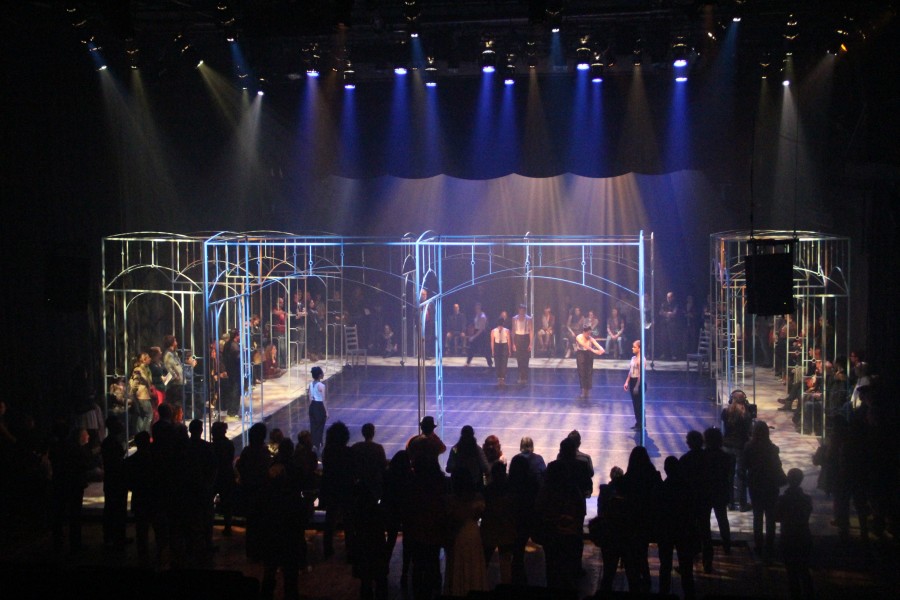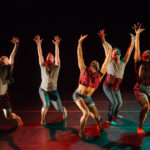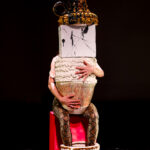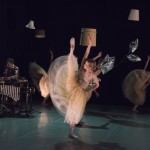Leigh Donlan reports from Z Space in San Francisco:
A dance performance based on a Virginia Woolf novel? Now there’s something you don’t see everyday in dance. As the audience arrived at Z Space for Liss Fain’s After the Light, we were greeted by a video installation by Fain in the lobby. The video portrays a woman submerged in water, her body being softly manipulated by the water’s invisible tides. It was dreamy yet haunting, as we inevitably recalled the true story of Woolf loading her coat pockets full of rocks before taking her last swim in a river. I wondered if we were in for an exploration of Woolf’s very dark side, and ultimate suicide.
There was no conventional seating for After the Light. Billed as an “immersive theatrical experience,” the audience was encouraged to roam about the proscenium of the stage, which was designed to suggest a foggy, nocturnal garden setting, lined with wrought iron gazebos over wood benches. I usually like to settle in for a show, get comfortable in my seat with my notebook and pencil, and focus, but this wasn’t an option. We were meant to move around the stage “at will,” to change our perspective on the unfolding dance.
The dance was based on one of Woolf’s most compelling works, The Waves, an experimental novel published in 1931 that Woolf called a “playpoem” because of its fusion of prose and poetry and stream-of-consciousness style, a boundary-breaking narrative form at the time. The novel follows six narrators – who some critics believe were influenced by literary and artistic figures from Woolf’s brilliant milieu – from childhood through adulthood, as they react to their life experiences; rather than relating facts and events in a straightforward narrative fashion, we are introduced to the inner workings of their minds and emotions. The challenge in dance is to use the vocabulary and the possibilities and limitations of the theatrical setting in as subtle and powerful a way as Woolf used her language.
In After the Light, excerpts from the text were read by two actors (Marty Pistoe and Val Sinckler) as six dancers, androgynously clad in black pants, white tank-tops and suspenders, moved about the square of the stage. Notably, there was no designated downstage or upstage; the dancers constantly changed directions, with center stage remaining the fulcrum. Fain’s intent was to use the read text as a sort of musical score, the dancers responding to the rhythms and cadences of the voices. The results were unpredictable – especially with the wandering audience – and mostly fascinating. Reacting to tone of voice or word, the dancers’ movements changed quickly in direction or momentum, constantly interrupted by the next thought in the text. The movement seemed improvisational, though none of it was. The dancers had rehearsed with the text, phrase by phrase, guided simply by the voices and the silence in between. All of Fain’s dancers are classically trained and highly versatile, and make these shifts effortlessly smooth. A particular highlight were the vertical leaps, when the dancers alternately shot straight up into the air into a grande jeté in attitude. Also dazzling were the many rigorous lifts of the females into a perfectly vertical full body hold.
Overall, After the Light was elusive and sumptuous, its strengths radiating from the dancers and the carefully chosen text. But the “at will” roaming audience format didn’t work for me – for this performance, at any rate. As I would start to focus on a particular scene, my view would inevitably become obstructed by a fellow roamer, changing my perspective to the back of someone’s head, followed by an awkward shuffling around to try and gain a better view. Perhaps this was intended. Or perhaps some more thought could be given to the logistics.
Apart from the challenges faced by us shorter members of the audience, After the Light was an intelligently constructed, thought-provoking work that closely mirrored Woolf’s shifting monologues in this groundbreaking piece of literature. Similar to the novel, this work lacks a linear storyline, requiring the roving audience, with its unstable, constantly shifting perspective, to piece together events and their impact on the characters from fragments of text and movement. We were to interpret the dancer’s bodies as text and their movements as stream-of-consciousness, finely punctuated with quivers and sweat.







